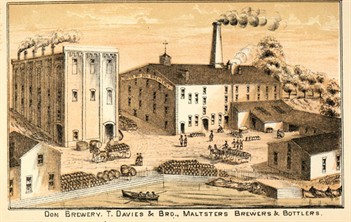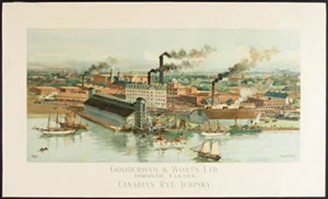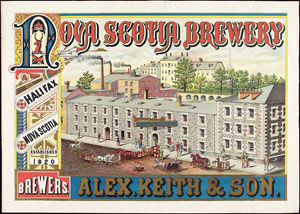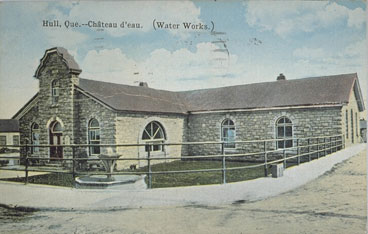Cheers!: Eastern Canada's 19th Century Brewery and Distillery Industry
With the return of summer, patios everywhere are alive with
patrons eager to soak up the warm rays of the sun while enjoying an
ice cold brew in the company of friends. Despite ambivalent
social and moral attitudes toward alcoholic beverages over the
years, Canadians have been taking pleasure in "fortified" drinks
for generations. Because of its popularity, an entire
industry based on the production, sale and, in some cases, the
illegality of booze blossomed in Canada after 1850. Evidence
of large-scale brewing and distilling is still visible in many
urban centres throughout eastern Canada. These places are
testimonies of past social patterns of recreation and, for some,
social evils which continue to the present.
Early European colonists in North America brought with them a
thirst for alcoholic drinks as well as the traditional knowledge
for producing this commodity. In New France, certain Catholic
orders began breweries as early as 1620 while colonists soon after
initiated their own private brewery enterprises. Under a
Royal Charter by the French monarch Louis XVI, Intendant
Jean Talon established a brewery in Québec in 1668. After the
1760 British conquest of New France, immigrants from the British
Isles continued the practice of establishing small-scale breweries
in the Maritime colonies, and in Upper and Lower Canada (now
Ontario and Québec), one of these being famed brewer John Molson
who began his own brewery in Montréal in 1786. But a social
shift in the mid-1830s put a damper, albeit short-lived, on the
liquor industry, as anti-drinking crusaders successfully advocated
temperance...
 As a result of the
Industrial Revolution which swept eastern North America beginning
in the 1840s, a renewed thirst for the "devil's water" was on the
rise among the emerging working class, in turn leading to higher
demand for spirits which the new economy would now quench! It
was in populated urban settings that large commercial ventures
began with the construction of facilities to produce considerable
amounts of spirits and beer for local markets and, as
transportation improved, for national retail. Toronto was one
such market where huge complexes of imposing structures, such as
the Don Brewery located along the Don River,
dominated the townscape. One of the country's most successful
distilleries was established by William Gooderham and
brother-in-law James Worts in 1837. As one of the biggest
distilleries in the world at one time, the Gooderham and Worts Distillery, now a National
Historic Site and trendy Toronto landmark, grew
As a result of the
Industrial Revolution which swept eastern North America beginning
in the 1840s, a renewed thirst for the "devil's water" was on the
rise among the emerging working class, in turn leading to higher
demand for spirits which the new economy would now quench! It
was in populated urban settings that large commercial ventures
began with the construction of facilities to produce considerable
amounts of spirits and beer for local markets and, as
transportation improved, for national retail. Toronto was one
such market where huge complexes of imposing structures, such as
the Don Brewery located along the Don River,
dominated the townscape. One of the country's most successful
distilleries was established by William Gooderham and
brother-in-law James Worts in 1837. As one of the biggest
distilleries in the world at one time, the Gooderham and Worts Distillery, now a National
Historic Site and trendy Toronto landmark, grew  steadily throughout the
second half of the nineteenth century to include several dozen
buildings for such uses as processing raw materials to storing
goods awaiting export. Today, while Gooderham and Worts is no
longer a distillery, the impressive handcrafted beers of Mill
Street Brewery are once again shipped out from the warehouse of
this historic place to be toasted and enjoyed by the public.
steadily throughout the
second half of the nineteenth century to include several dozen
buildings for such uses as processing raw materials to storing
goods awaiting export. Today, while Gooderham and Worts is no
longer a distillery, the impressive handcrafted beers of Mill
Street Brewery are once again shipped out from the warehouse of
this historic place to be toasted and enjoyed by the public.
Canada's distilling industry was equally put on the map by the
efforts of Joseph E. Seagram who purchased the Granite Mills and
Distillery of Waterloo, Ontario in 1883 and renamed the business J.
E. Seagram's Distillery. Seagram was a
brilliant entrepreneur who realized the marketing potential for
brand names. His newly distilled whiskey, Seagram's '83, was
marketed in Canada and the United States with huge success.
Today, the Seagram's label is internationally recognized.
Another long-standing and celebrated name in Canada's alcohol
industry is Alexander Keith. Educated in the art of brewing
in Scotland, Keith immigrated to Halifax, Nova Scotia at the age of
22. He began his own brewery in 1822 and expanded in 1837
with the construction of a large ironstone brewery building near
the Halifax waterfront. Not only was Keith a master brewer,
he was equally a successful politician whose handsome residence,
Keith Hall, built in 1863 and connected to his brewery via a
tunnel, expressed his social status.  Demand for alcoholic beverages in
Halifax continued despite increasing efforts to eliminate the
consumption of libations at the end of the nineteenth
century. Alexander Keith passed away in 1873 but his legacy
endures through Keith Hall and Brewery which still stands to
this day.
Demand for alcoholic beverages in
Halifax continued despite increasing efforts to eliminate the
consumption of libations at the end of the nineteenth
century. Alexander Keith passed away in 1873 but his legacy
endures through Keith Hall and Brewery which still stands to
this day.
Another building confirming the deeply rooted relationship
between libations and Maritimers are the Newman Wine Vaults in St. John's, Newfoundland
and Labrador. The wine vaults were established in the early
nineteenth century by Newman and Company to age port wine imported
from Portugal. Although inconspicuous in style from the
outside, the vaults' interior consisted of large barrel vaulted,
below grade cellars allowing for a constant temperature and thus
ideal conditions during the aging process.
Temperance movements varied in success throughout the second
half of the nineteenth and early-twentieth century, their major
victory being a nation-wide ban on intoxicating drinks, known as
the Prohibition Era, following the First World War. In 1878,
the government passed the Canada Temperance Act (Scott
Act) which gave municipalities the option of voting themselves
"dry." It was in the Maritimes that this Act found the most
support for the majority of counties chose to prohibit the sale of
alcohol. Yet, not everyone shared this attitude of
sobriety. Anxious to turn a profit, bootleggers engaged in
the illicit trade of smuggling alcohol to a population thirsting
for a "wet" drink. Along the Atlantic Coast, and in many
other parts of the country, this illegal business often occurred in
secluded areas far from the long arm of the law. One such
place was Friar's Cove, Harbour Breton, Newfoundland and
Labrador where bootleggers helped deliver a steady supply of booze
to local purveyors and citizens. 
Today, while big name breweries and distillers remain popular
consumer choices, there is also a growing appreciation for
microbreweries and brewpubs, where beer is hand-crafted on a
limited scale following more traditional brewing methods.
Some historic places are ideally suited to accommodate this
specialized industry, such as the Château d'eau in Gatineau, Québec which was
initially constructed in 1902-05 to supply the town with fresh
water but has recently been converted to the trendy brewpub
Les Brasseurs du Temps. Another example where a
historic place built for one purpose has been converted to
accommodate a brewery is Toronto's John Street Roundhouse which is now home to
Steam Whistle Brewing and open for guided tours.
Whether an enthusiast of alcoholic beverages or not, it is
undeniable that Canadians share a long and ambivalent relationship
with booze. Many places still communicate this storied past
and you are invited to visit them and raise a glass to the pioneers
of Canada's early brewing and distilling industry.
Cheers!